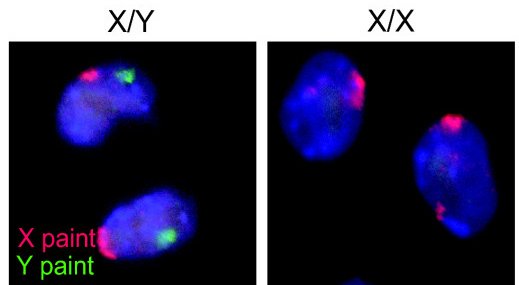Sex Chromosomes and Sex-limited Inheritance
Back in my secondary school days, there use to be this girl that was always on beret even though the cap is not part of the school's dress code. Why the school management decided to indulge this particular girl and frown at or even punish every other girls that add any article of dressing that is not part of the standard requirements remained a long time mystery and a subject of gossip among students, especially the ladies, until this fateful day. An argument ensued between the beret girl and some girls in the school. It got so intense that a physical battle ensued and while people were trying to dispel the situation and separate the fight, someone out of the blues removed the beret of the girl and all hell was let loose. Time stood still for a few seconds and those fighting, including the girl herself, paused momentarily to fully absorb the implication of what just happened
She was bald-headed.
What!!! A bald-headed girl?
Several theories started flying around on what could have led to the baldness of the girl. I mean, we all have seen bald-headed males at some points in our life but cannot say the same for females. Some said it could be due to an accident, some agreed that it is a spiritual attack, but the strongest one was the the young girl is a witch.
A witch?
To cut the long story short, the girl had to tranfer to another school to avoid the shame that came with the revelation.

Sex Chromosomes and Sex-limited Inheritance
The existence of sex chromosomes as a means of sexual dimorphism has created a dichotomy in the inheritance of characters across generations - from parents to offspring. All other chromosomes that do not participate in determining the sex of organisms are referred to as autosomes. As we all know that chromosomes carry traits, hence, the traits on autosomal chromosomes are categorised as autosomal traits or inheritance while those carried sex chromosomes are known as sex-limited traits/inheritance. The consequence of this is that a peculiar dynamics exist in the inheritance of sex-limited traits depending on the sex chromosomes of males and females as opposed to autosomal traits. This is why some traits are peculiar to a particular gender of organism and are rarely found or totally absent in the other gender of the same organism.
Sex-limited Inheritance in Humans
In my last post, the XY sex chromosome system that defines sexual dimorphism in humans was extensively discussed in which it was pointed out that the X chromosome of the heterogametic male usually comes from his mother while for the homogametic female, one X chromosome comes from the father while the other comes from the mother. There are two types of sex-limited traits or inheritance :
- X-linked inheritance
- Y-linked inheritance
The X-linked inheritance are limited to the X chromosomes of the sex chromosomes only. They can be recessive or dominant. When a X-linked trait is recessive, the implication is that a female would need one recessive allele on each X chromosome for her to be phenotypically affected by the trait while a male would only need one recessive allele (after all, he has only one X chromosome). In addition, a female can be a carrier of the trait in heterozygous condition while a male is either affected or not and this kind of trait usually skips generations only to reappear in the future ones. This is why the frequency of males that are affected for X-linked recessive traits far outweighs that of females. A good example is the baldness situation narrated above. The trait is X-linked and recessive. Hence, it is rarely found in females but not that it cannot happen. A simple genetically explanation could have enlightened everyone back then instead of the ridiculous theories that were being formed.
For dominant X-linked trait, only one dominant allele is needed on either of the X chromosomes of the female and the only X chromosome of the male. In such case, both the male and the female genders have an equal chance of inheriting such trait in the population. This kind of inheritance is persistent across generation and does not skip any, unlike the recessive trait.

The Y-linked trait is limited to the Y chromosome only. The implication of this is that all the male individuals within the family will be affected for such trait while females have nothing to do with such traits since they do not have Y chromosome. Recall that the male's chromosome is XY while that of the female is XX.
Analysing the bald-headed girl's situation
Bald headedness is X-linked and recessive, meaning that each of the X chromosome of the girl carries a recessive allele for the trait. She must have inherited one allele from her mother and the other from her father. Thus, her father must have been a bald person because all that is required for a man is to have one recessive allele. The mother of the girl could have been a carrier for the trait or affected herself. If she's affected by the trait, it means all the girl's siblings, be it male or female would be bald. If the mother is a carrier, it means that all the females she will give birth to would either be affected or be a carrier for the trait while all the males would either be affected or unaffected at all. Looking back now, I really wish I knew the girl's family back then.
Congratulations @hadji! You have completed the following achievement on the Hive blockchain and have been rewarded with new badge(s) :
You can view your badges on your board and compare yourself to others in the Ranking
If you no longer want to receive notifications, reply to this comment with the word
STOPDo not miss the last post from @hivebuzz:
Congratulations @hadji! You received a personal badge!
You can view your badges on your board and compare yourself to others in the Ranking
Do not miss the last post from @hivebuzz:
Thanks for your contribution to the STEMsocial community. Feel free to join us on discord to get to know the rest of us!
Please consider supporting our funding proposal, approving our witness (@stem.witness) or delegating to the @stemsocial account (for some ROI).
Please consider using the STEMsocial app app and including @stemsocial as a beneficiary to get a stronger support.